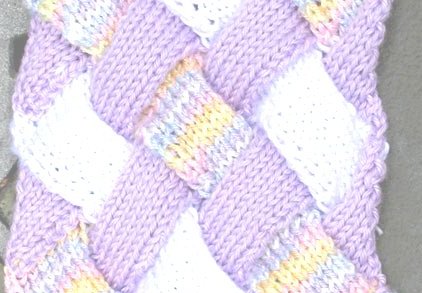If you are unfamiliar with entrelac, instead of what you see above, it usually looks like this example from knitting daily:
http://www.knittingdaily.com/media/p/48939.aspx (Isn’t that lovely?)
The yarn changes color, so each block is next to a similar color, and gradually changes as you knit upward block by block. Since entrelac appears to be inter-laced, my brain always has the urge to see what it would look like if it were really woven like a basket. So, I had to make one to see it, and here it is!You can make one too if you want, here are some instructions on how to make either scarf. Whenever I want to make entrelac, I take Eunny Jang’s Entrelac Block by Block, pages 2, 3 and 4 with me, and do exactly what it says. You may need to sign up to get it, but the download is free. http://www.knittingdaily.com/media/p/24512.aspx
(Tip on that download: It sounds weird at first to cast on only 24 stitches for the first row of triangles, but it’s correct – this will give you a scarf like in my photo, about 7 inches wide (17 1/2cm.) if you’re using something equivalent to Caron Simply Soft yarn and size 7 needles.)
At first I thought doing this Woven Entrelac would be terrible! You have to cut the yarn a lot, and you will have lots of ends, (which you don’t have with regular entrelac and color changing yarn). But I figured out how to work them in as I go, so there’s no big end-work-in-fest when it’s finished. It’s okay! The back of entrelac is not pretty anyway, here is what that comes out looking like:
 Working in ends as you go: After cutting and tying a new strand, I work the row where you pick up loops on the next square normally, and work back to the knot. Then I hold the ends between the needle/loop and the working yarn so that when the next stitch is made, it gets trapped under the working yarn. Hold it between the needle and working yarn for each following stitch until it’s all the way trapped. I usually alternate, holding it upward one stitch, then holding it downward for the next one. I don’t think it matters though, as long as it gets trapped in there somehow. Then you just have the little tips sticking out. For the first side triangle I gradually just work those ends away from the edge.
Working in ends as you go: After cutting and tying a new strand, I work the row where you pick up loops on the next square normally, and work back to the knot. Then I hold the ends between the needle/loop and the working yarn so that when the next stitch is made, it gets trapped under the working yarn. Hold it between the needle and working yarn for each following stitch until it’s all the way trapped. I usually alternate, holding it upward one stitch, then holding it downward for the next one. I don’t think it matters though, as long as it gets trapped in there somehow. Then you just have the little tips sticking out. For the first side triangle I gradually just work those ends away from the edge.
How to make Woven Entrelac
You will have one color that is used for more of the scarf (in this case, purple, color #3), and two other colors that are used less (#1 and #2), like this:
 (You can leave the ends hanging like that on the first row where they can blend in when you add fringe.)
(You can leave the ends hanging like that on the first row where they can blend in when you add fringe.)
Then knit with the colors as follows, using the knitting daily pattern:
Cast on with color 1:
Base triangles: 1st one: color 1; 2nd one: color 2; 3rd one: color 1
Tier 1:
First side triangle: Always color 3 (no cutting the yarn this tier – yay!)
Continue with row of blocks: Always color 3
Second side triangle: Always color 3 (cut yarn only at end of second side triangle)
Tier 2:
Second tier of blocks: Always colors 1 and 2. Swap order each time you do this tier, (just do the opposite of what you did the last time you did the second tier).
More details on second tier: Since you did color 1, color 2, color 1 for the base triangles, when you get to this tier the first time, do color 2, color 1, color 2. Then the next time you get to the second tier, it will be color 1, color 2, color 1 again. After that point, it will just be obvious to you what should come next. It should look like a basket, and each color flows under one and out the same color. Feel free to print this light picture of my scarf and write your own color names on it where they will go. (I had to draw it out before I started.)
Alternative weaving: You could also knit strips with 45 degree angled ends and just weave them, but if they were stockinette like in entrelac, they would roll into i-cords, so would need stitching on all of the edges to look the same. I don’t like hand sewing, so doing it that way sounds less fun to me. For those who like hand sewing, maybe that would be fun for them. If your strips were garter or another flat-lying stitch, weaving those would probably be nice, and much faster than entrelac, but I haven’t tried it.
My yarn: Caron Simply Soft -color Baby Bright (color 1); Caron Simply Soft -color white (color 2); Caron Simply Soft -color Orchid (color 3). Size 7 needles.




